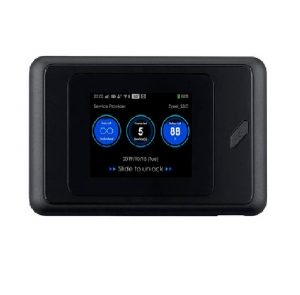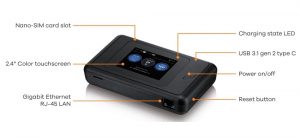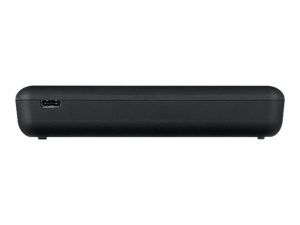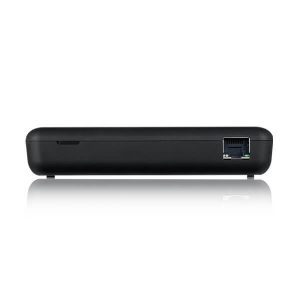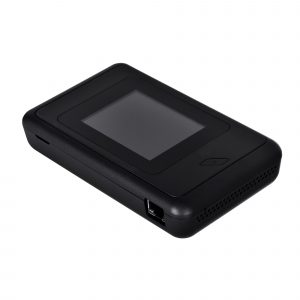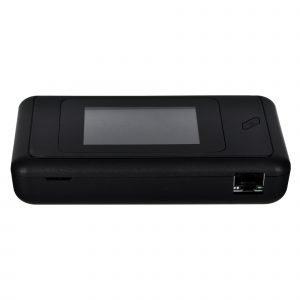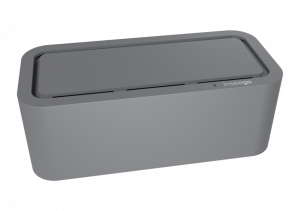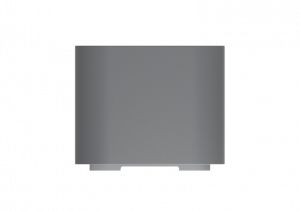未選択
-
[PR]
×
[PR]上記の広告は3ヶ月以上新規記事投稿のないブログに表示されています。新しい記事を書く事で広告が消えます。
-
Zyxel NR2101 Mobile 5G Router Test
Zyxel NR2101 was presented to the public last year and now the most affordable mobile 5G routers is available in mid-2021. Like the Netgear Nighthawk M5 are sold for around 850.00USD, the Zyxel 5G router is available at just around 400 euros. The Zyxel NR2101 comes with a replaceable battery, and it can use the current WiFi 6 standard and even has an integrated RJ45 Ethernet LAN connection. The 5G modem theoretically achieves speeds of up to 4 GBit/s.
The Zyxel NR2101 is delivered in a small box together with a 5300 mAh battery. There is also a Quick Charge power supply unit (output max. 18 watts) and a short USB to USB Type-C cable included in the box. A multilingual quick start guide is also included and makes it easier to use.
The setup is easy and takes 3 to 5 minutes. First, the cover must be removed from the back of the NR2101 in order to insert the nano SIM card and the battery. Here you should directly write down the WLAN name as well as the WLAN password and the access data for the web interface, the data is printed on a label in the battery compartment.
Internet access and WLAN can then be configured either directly on the large touchscreen or via the web interface in a browser; the device must of course be connected via LAN, WLAN or USB.
Connections and display
The Zyxel NR2101 5G router has a USB Type-C connection and a Gigabit RJ45 Ethernet LAN connection. The USB connection can be used both to charge the battery and to operate it directly on the power supply unit, without the battery being inserted. A data connection ("USB tethering") can also be easily established via the USB port.
In addition to the power button, there is a small LED on the front that shows the operating status in multiple colors. Most important, of course, is the large color display, which can be used to operate all important functions thanks to the touchscreen function.
5G modem in the test
The 5G router has a Qualcomm Snapdragon X55 5G modem. All important frequency bands for Europe are supported, for example 5G bands n1, n3, n20, n28 and n78 as well as LTE bands 1, 3, 7, 8, 20, 28, 32, 38 and 46. UMTS/3G is still supported.
In the test, the download speeds were up to 850 Mbit/s in the 5G network, if band n78 was available. Up to 150 Mbit/s were possible in the uplink. A cable connection (USB tethering) was required for this, however, and only slightly lower download speeds of around 650 Mbit/s were usually possible via WLAN. In the 5G network with band n1 (DSS operation, Dynamic Spectrum Sharing ), download rates of around 300 Mbit/s and uploads of around 120 Mbit/s were usually possible.
The Zyxel NR2101 also delivered very good download speeds of 300 Mbit/s and more in the test in the LTE network. In the upload, the speeds of up to 80 Mbit/s were well below the performance in the 5G network.
WLAN and LAN
The 5G mobile router supports the new WiFi 6 standard and transmits on both 2.4 GHz and 5 GHz. Up to 16 devices can be connected via WLAN at the same time. This is certainly sufficient for the private sector, but the maximum of 16 devices could possibly connect with the Zyxel NR2101 Router.
In the test, the maximum speed was 1.2 Gbit/s, provided WiFi 6 could be used. With an older WiFi 5 device, 867 Mbit/s was still possible. In the 2.4 GHz band, the NR2101 theoretically achieves up to 574 Mbit/s. The WiFi range was decent in the test, an apartment of up to around 80 square meters or a small house can be supplied satisfactorily.
Battery pack
The exchangeable battery enabled an operating time of around 10 hours in the test. Depending on the application, a slightly shorter running time is also conceivable, for example if there are a lot of cell changes (in the train or in the car). Thanks to the quick charging power supply unit, the router is quickly recharged.
Software and web interface
Almost all functions can be configured directly on the device via the touchscreen, but a browser web interface is also available on request. This is clearly structured, but has the peculiarity that it can only be operated when the display is switched off. In the web interface, for example, the 5G and LTE frequency band used can be read, and the cellular technology can also be set manually, for example.
Conclusion on the Zyxel NR2101
The Zyxel NR2101 made a good impression in the test. The device is fully compatible with the 5G networks in the Europe and reached high speeds, but does not break any records. Operation via the touchscreen is simple and reliable. There is criticism for the lack of connections for an external cellular antenna, and the Internet access via LAN / WLAN as a supplement to the integrated modem would have been nice.
PR -
AVM FRITZ! Box 6850 5G Router Will be Available Soon
AVM announced a 5G router - the FRITZ! Box 6850 5G in 2019. The device never came on the market, instead a version with LTE modem - the FRITZ! Box 6850 LTE - was released in 2020. In the course of the summer of 2021, the 5G version of the FRITZ! Box 6850 should finally come onto the market. AVM has already mentioned technical details, but the company has so far been silent on the price.
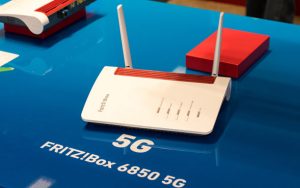
Gigabit speed over LTE and 5G
Inside the AVM FRITZ! Box 6850 5G, a Qualcomm modem works, which supports speeds of up to 1.3 Gbit/s when downloading via 5G and up to 1 Gbit/s when downloading via 4G/LTE. The modem can also use 3G/UMTS, but the UMTS networks are currently being switched off in Germany, so that this technology is irrelevant, at least in this country.
The following frequency bands are supported according to AVM:
- 5G: n1, n3, n5, n7, n8, n20, n28, n38, n40, n41, n78
- 4G / LTE: 1, 3, 5, 7, 8, 20, 28, 32, 38, 40, 41, 42, 43
According to AVM, the FRITZ! Box 6850 5G is fully compatible with the current 5G networks, for example DSS (Dynamic Spectrum Sharing) is also supported. It is not clear from the information available whether the FRITZ! Box 6850 5G can also use 5G SA mode (standalone) in addition to 5G NSA (non-standalone).
Further Technical Specifications
The AVM FRITZ! Box 6850 5G is technically very similar to the FRITZ! Box 6850 LTE and the FRITZ! Box 7530. Both the shape of the housing and the technical data are almost identical. On the back there are two SMA connections for an external cellular antenna as well as four Gigabit LAN ports (RJ45) and a USB 3.0 interface. If you will buy the external 5G antenna for FRITZ! Box 6850 5G, we recommend this one: https://www.4gltemall.com/5g-external-antenna.html .
The FRITZ! Box 6850 5G is one of the world's first 5G routers with an integrated telephone system and DECT function. There is also a TAE / RJ11 interface for an analog telephone.
The AVM 5G Router supports WLAN on both 2.4 GHz and 5 GHz, the maximum speed is 866 Mbit/s in the 5 GHz band. Unfortunately, the new WiFi 6 standard is not supported.
Market launch in summer 2021
The AVM FRITZ! Box 6850 5G should appear in summer 2021, there is no price yet. As soon as it is available, the device will be tested.
-
Philips Type-C Laptop Docking Station
There are many variant models for the Philips Laptop docking station. They have different interfaces and pls check the pictures below for your reference.
Model 1: HDMI x 1 + USB x 2 + PD60W x 1
Brand: Philips
Model: 4 in 1 Type-C Smart Docking Station
Interfaces:- HDMI x 1
- USB2.0 x 1
- USB3.0 x 1
- PD60W x 1
Cable Length: 15cm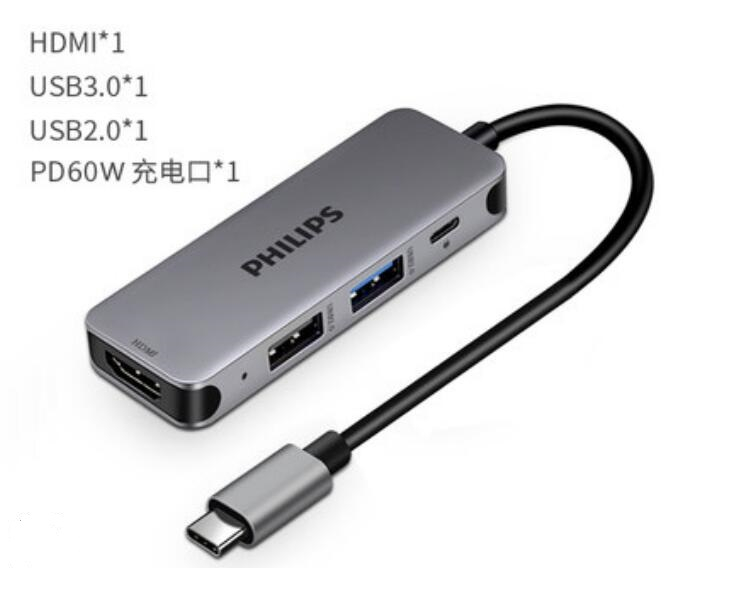
-------------------------------------------------------------------------------------------------------------------------------------------------------------
Model 2: USB x 3 + Ethernet (100M) Port x 1
Brand: Philips
Model: 4 in 1 Type-C Smart Docking Station
Interfaces:
- USB3.0 x 3
- 100M Ethernet Port x 1
Cable Length: 15cm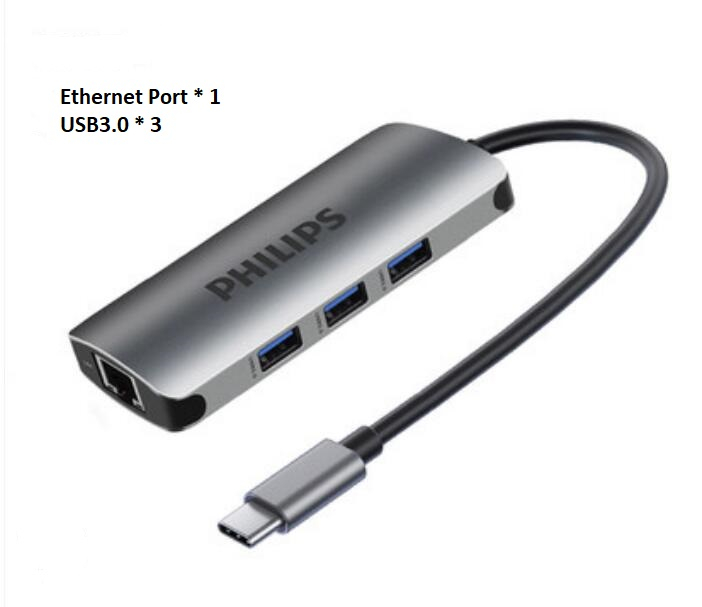
-------------------------------------------------------------------------------------------------------------------------------------------------------------
Model 3: USB3.0 x 4
Brand: Philips
Model: 4 in 1 Type-C Smart Docking Station
Interfaces:
- USB3.0 x 4
Cable Length: 15cm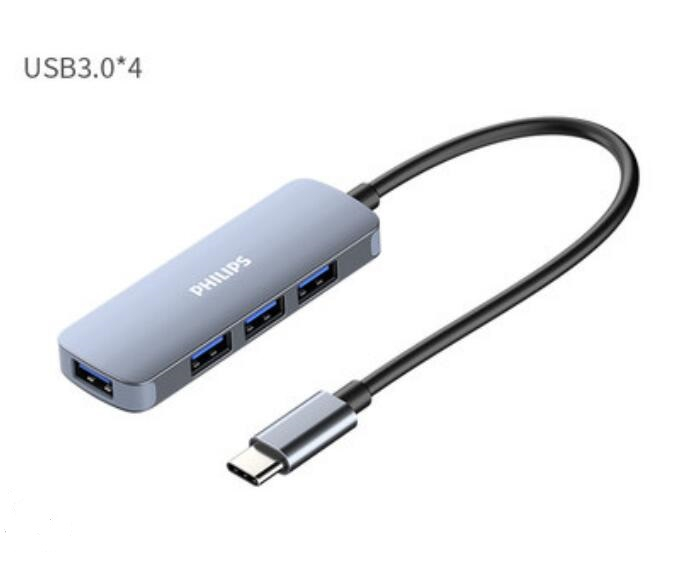
-------------------------------------------------------------------------------------------------------------------------------------------------------------Model 4: HDMI x 1 + USB3.0 x 3 + PD100W x 1
Brand: Philips
Model: 5 in 1 Type-C Smart Docking Station
Interfaces:
- USB3.0 x 3
- HDMI x 1
- PD100W x 1
Cable Length: 15cm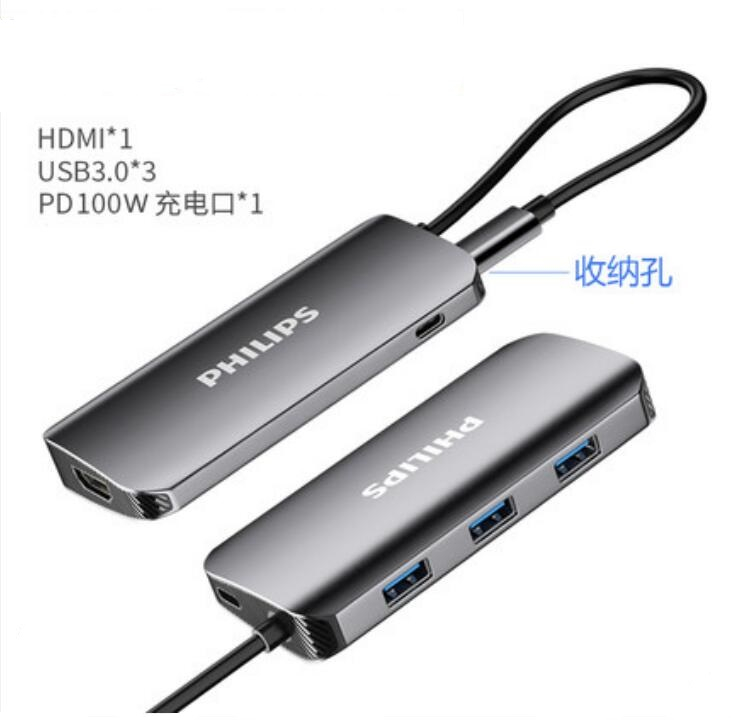
-------------------------------------------------------------------------------------------------------------------------------------------------------------Model 5: HDMI x 1 + USB3.0 x 4
Brand: Philips
Model: 5 in 1 Type-C Smart Docking Station
Interfaces:
- USB3.0 x 4
- HDMI x 1
Cable Length: 15cm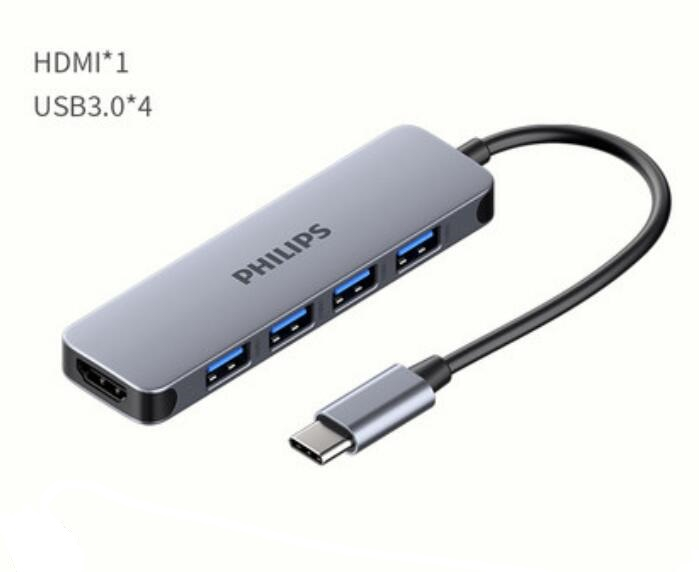
-------------------------------------------------------------------------------------------------------------------------------------------------------------Model 6: HDMI x 1 + USB3.0 x 3 + PD100W x 1
Brand: Philips
Model: 5 in 1 Type-C Smart Docking Station
Interfaces:
- USB3.0 x 3
- HDMI x 1
- PD100W x 1
Cable Length: 15cm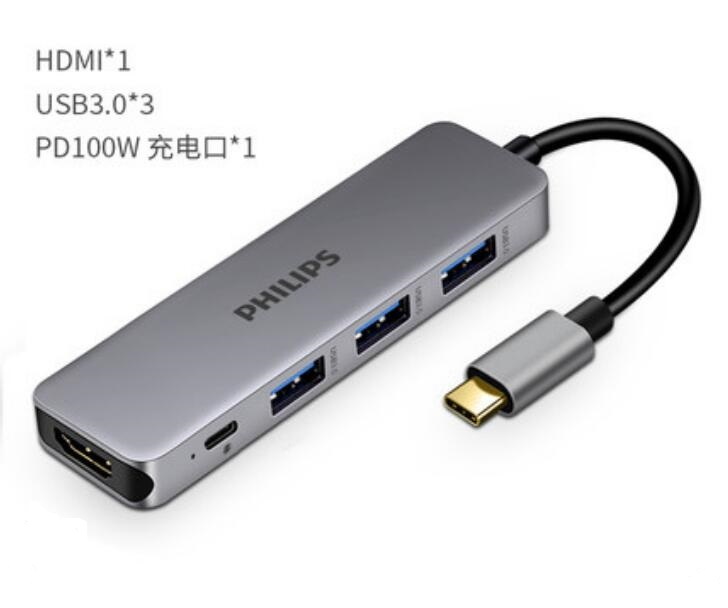
-------------------------------------------------------------------------------------------------------------------------------------------------------------Model 7: USB3.0 x 4 + PD100W x 1
Brand: Philips
Model: 5 in 1 Type-C Smart Docking Station
Interfaces:
- USB3.0 x 4
- PD100W x 1
Cable Length: 15cm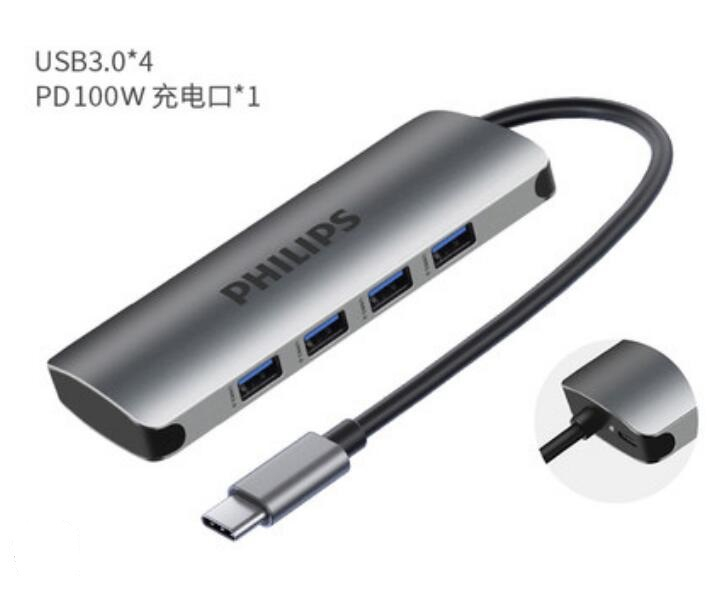
-------------------------------------------------------------------------------------------------------------------------------------------------------------
Model 8: HDMI x 1 + USB3.0 x 3 + PD x 1
Brand: Philips
Model: 5 in 1 Type-C Smart Docking Station
Interfaces:
- USB3.0 x 3
- HDMI x 1
- PD x 1
Cable Length: 15cm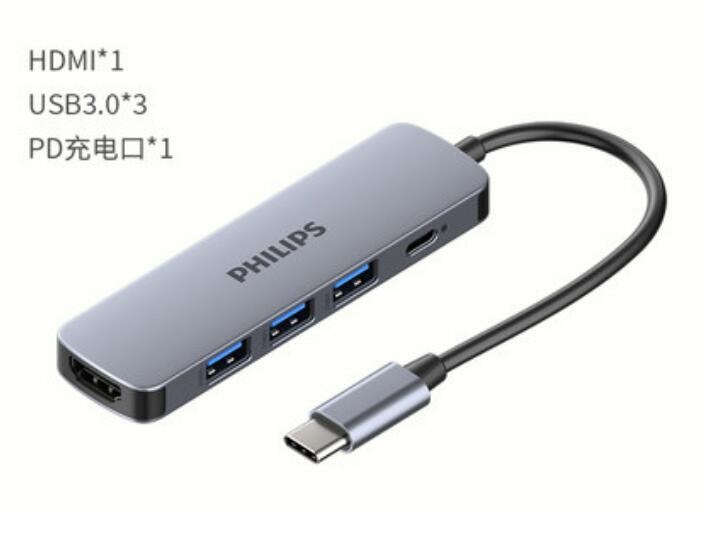
-------------------------------------------------------------------------------------------------------------------------------------------------------------
Model 9: Gigabit Ethernet Port x 1 + USB3.0 x 3 + PD100W x 1
Brand: Philips
Model: 5 in 1 Type-C Smart Docking Station
Interfaces:
- USB3.0 x 3
- Gigabit Ethernet Port x 1
- PD100W x 1
Cable Length: 15cm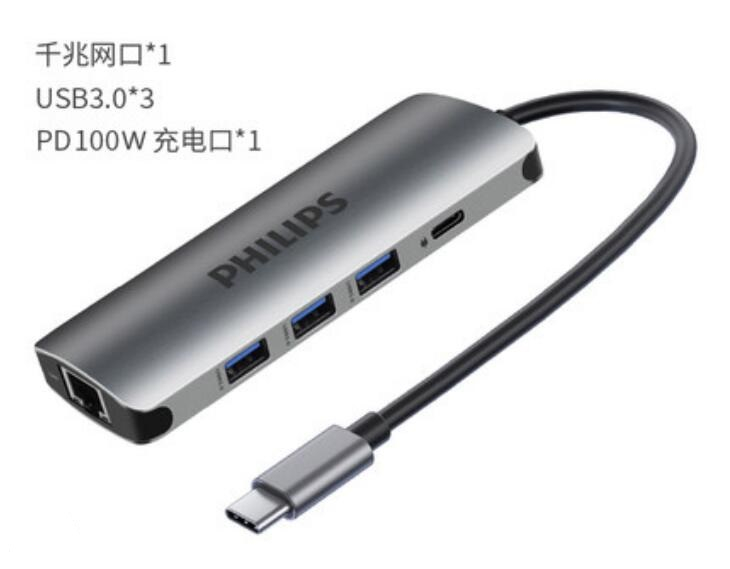
-------------------------------------------------------------------------------------------------------------------------------------------------------------
Model 10: Micro USB x 1 + USB3.0 x 3 + 100M Ethernet Port x 1
Brand: Philips
Model: 5 in 1 Type-C Smart Docking Station
Interfaces:
- USB3.0 x 3
- 100M Ethernet Port x 1
- Micro USB x 1
Cable Length: 15cm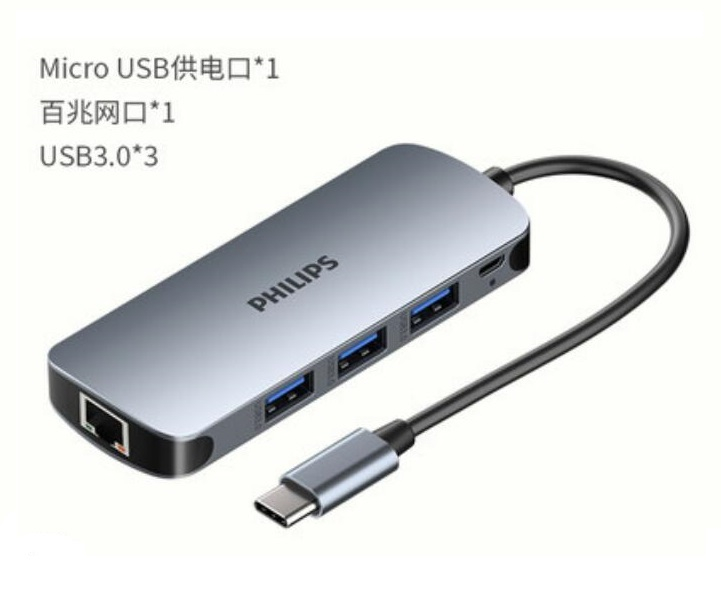
-------------------------------------------------------------------------------------------------------------------------------------------------------------Model 11: HDMI x 1 + USB3.0 x 2 + VGA x 1 + PD100W x 1
Brand: Philips
Model: 5 in 1 Type-C Smart Docking Station
Interfaces:
- USB3.0 x 2
- HDMI x 1
- VGA x 1
- PD100W x 1
Cable Length: 15cm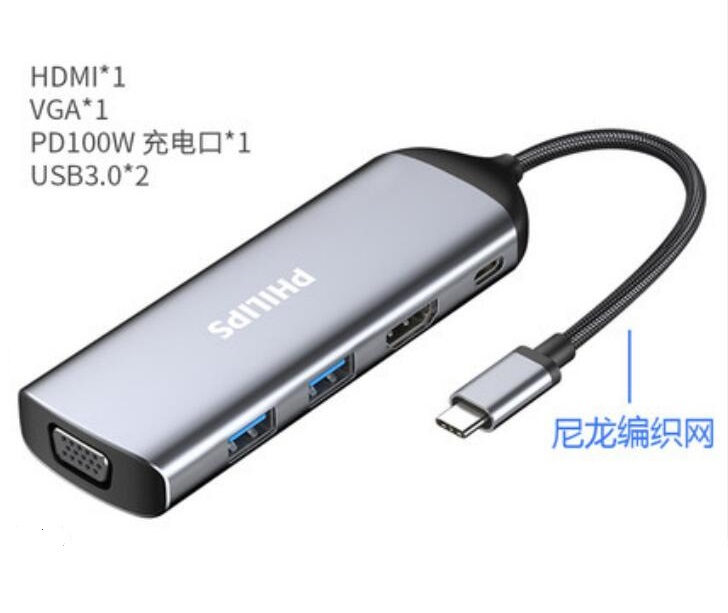
-------------------------------------------------------------------------------------------------------------------------------------------------------------
Model 12: USB3.0 x 3 + VGA x 1 + PD100W x 1
Brand: Philips
Model: 5 in 1 Type-C Smart Docking Station
Interfaces:
- USB3.0 x 3
- VGA x 1
- PD100W x 1
Cable Length: 15cm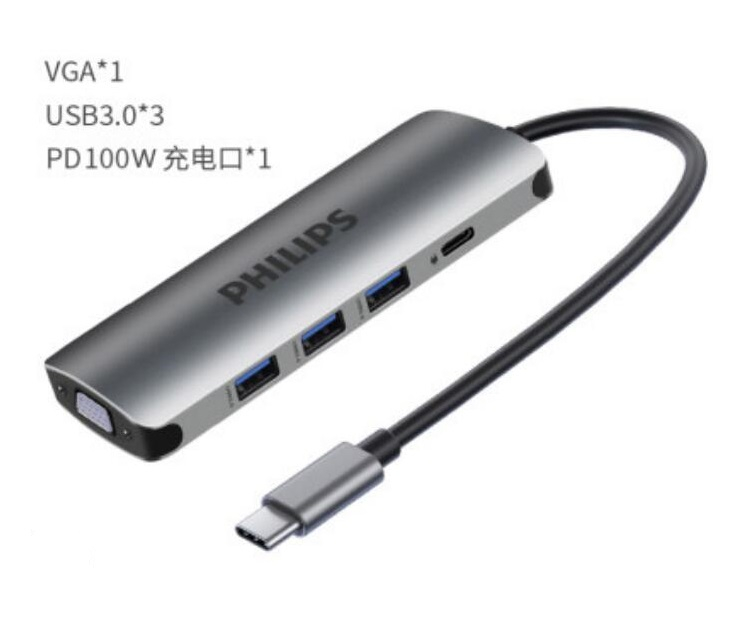
-------------------------------------------------------------------------------------------------------------------------------------------------------------
Model 13: USB3.0 x 3 + HDMI x 1 + PD100W x 1
Brand: Philips
Model: 5 in 1 Type-C Smart Docking Station
Interfaces:
- USB3.0 x 3
- HDMI x 1
- PD100W x 1
Cable Length: 15cm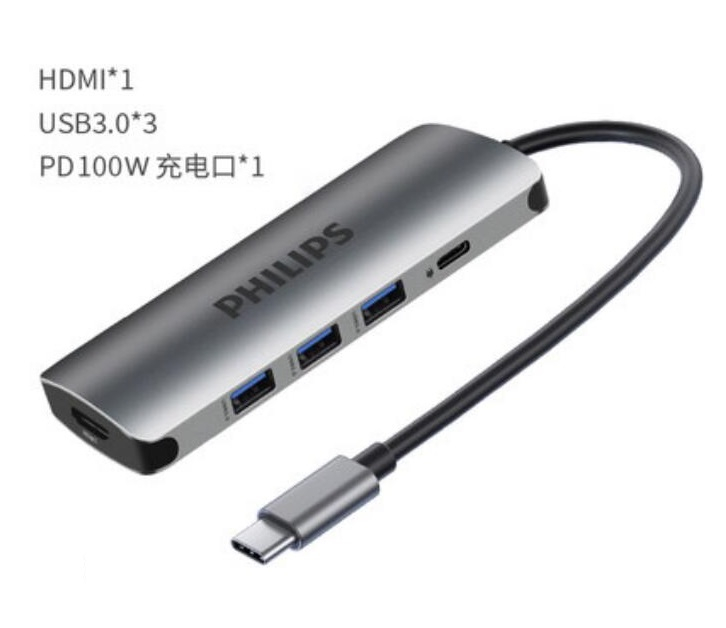
-------------------------------------------------------------------------------------------------------------------------------------------------------------
Model 14: USB3.0 x 3 + HDMI x 1 + SD Card Slot x 1 + TF Card Slot x 1
Brand: Philips
Model: 6 in 1 Type-C Smart Docking Station
Interfaces:
- USB3.0 x 3
- HDMI x 1
- SD Card Slot x 1
- TF Card Slot x 1
Cable Length: 15cm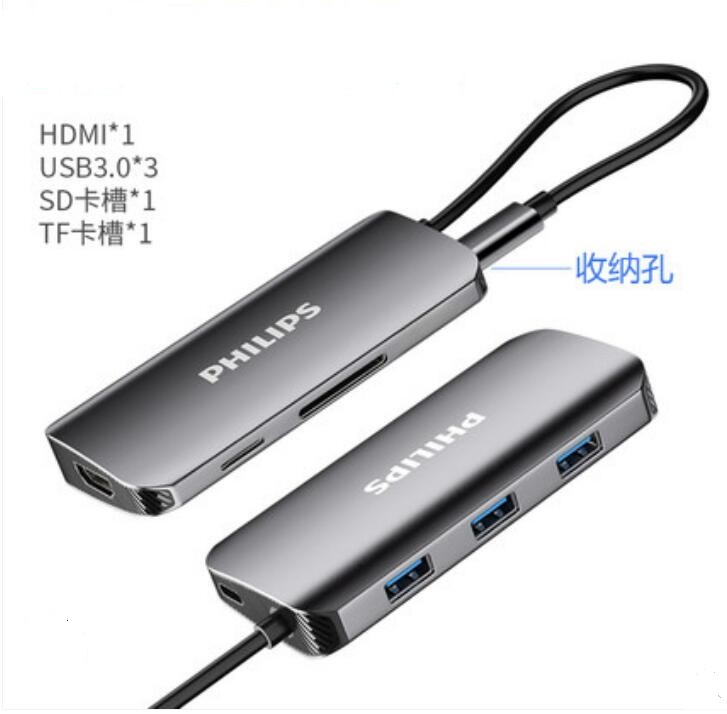
-------------------------------------------------------------------------------------------------------------------------------------------------------------
Model 15: USB3.0 x 3 + USB2.0 x 1 + HDMI(4K@30Hz) x 1 + Gigabit Ethernet Port x 1 + USB-C(PD100W + USB2.0 data) x 1
Brand: Philips
Model: 7 in 1 Type-C Smart Docking Station
Interfaces:
- USB3.0 x 3
- USB2.0 x 1
- HDMI(4K@30Hz) x 1
- Gigabit Ethernet Port x 1
- USB-C(PD100W + USB2.0 data) x 1
Cable Length: 15cm
-------------------------------------------------------------------------------------------------------------------------------------------------------------
Model 16: USB3.0 x 3 + HDMI x 1 + SD Card Slot x 1 + TF Card Slot x 1 + PD100W x 1
Brand: Philips
Model: 7 in 1 Type-C Smart Docking Station
Interfaces:
- USB3.0 x 3
- HDMI x 1
- SD Card Slot x 1
- TF Card Slot x 1
- PD100W x 1
Cable Length: 15cm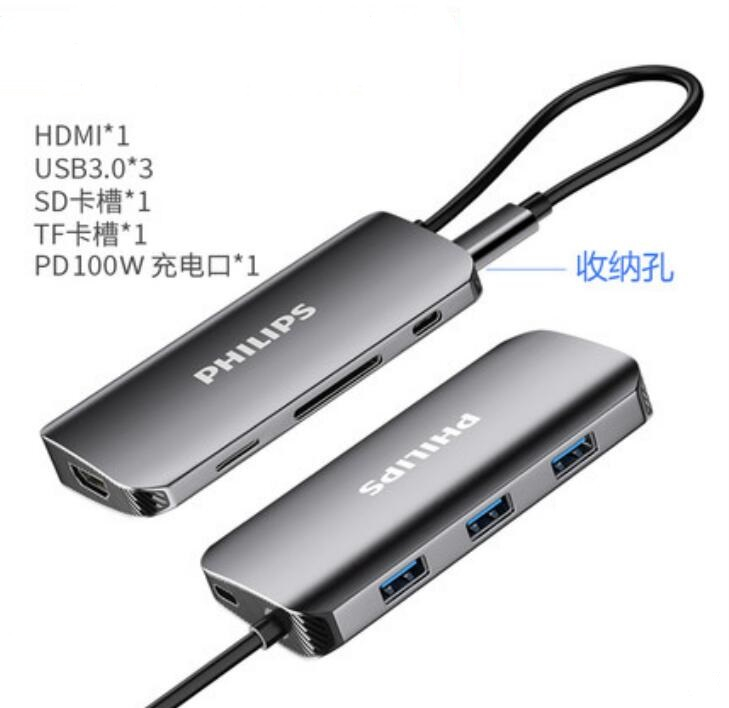
-------------------------------------------------------------------------------------------------------------------------------------------------------------
Model 17: USB3.0 x 3 + HDMI x 1 + SD Card Slot x 1 + TF Card Slot x 1 + PD60W x 1 + Gigabit Ethernet Port x 1
Brand: Philips
Model: 8 in 1 Type-C Smart Docking Station
Interfaces:
- USB3.0 x 3
- HDMI x 1
- SD Card Slot x 1
- TF Card Slot x 1
- PD60W x 1
- Gigabit Ethernet Port x 1
Cable Length: 15cm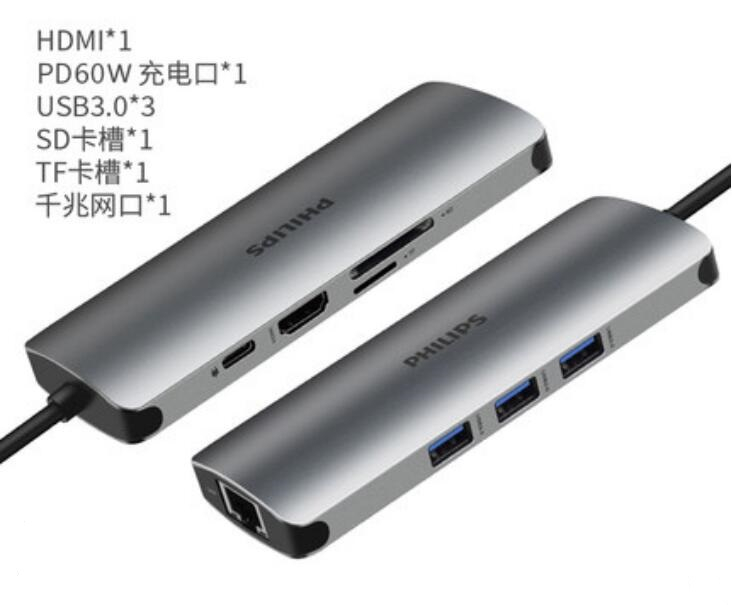
-------------------------------------------------------------------------------------------------------------------------------------------------------------Model 18: USB3.0 x 3 + HDMI x 1 + SD Card Slot x 1 + TF Card Slot x 1 + PD60W x 1 + Gigabit Ethernet Port x 1
Brand: Philips
Model: 8 in 1 Type-C Smart Docking Station
Interfaces:
- USB3.0 x 3
- HDMI x 1
- SD Card Slot x 1
- TF Card Slot x 1
- PD60W x 1
- Gigabit Ethernet Port x 1
Cable Length: 15cm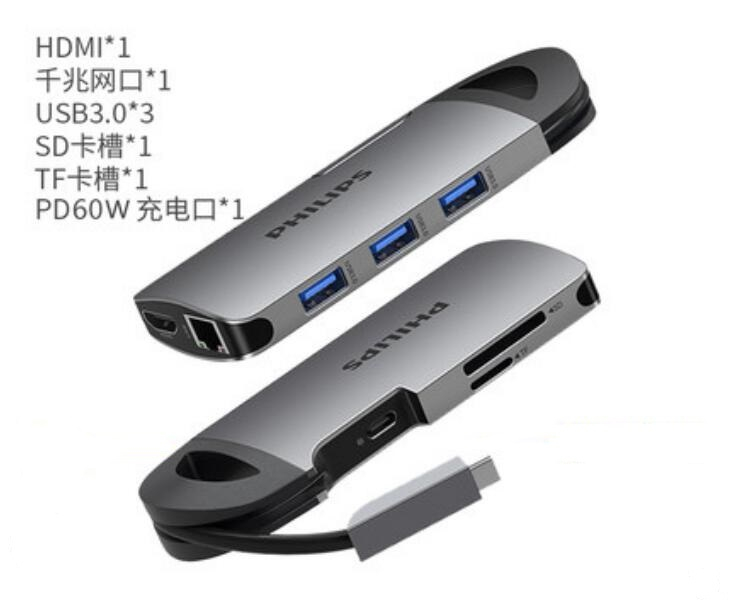
-------------------------------------------------------------------------------------------------------------------------------------------------------------
Model 19: USB3.0 x 2 + USB2.0 x 1 + HDMI x 1 + VGA x 1 + SD Card Slot x 1 + TF Card Slot x 1 + PD100W x 1 + Gigabit Ethernet Port x 1
Brand: Philips
Model: 9 in 1 Type-C Smart Docking Station
Interfaces:
- USB3.0 x 2
- USB2.0 x 1
- HDMI x 1
- VGA x 1
- SD Card Slot x 1
- TF Card Slot x 1
- PD60W x 1
- Gigabit Ethernet Port x 1
Cable Length: 15cm
-------------------------------------------------------------------------------------------------------------------------------------------------------------
Model 20: USB3.0 x 3 + HDMI x 1 + VGA x 1 + SD Card Slot x 1 + TF Card Slot x 1 + PD100W x 1 + Gigabit Ethernet Port x 1 + 3.5mm Audio Port x 1
Brand: Philips
Model: 10 in 1 Type-C Smart Docking Station
Interfaces:
- USB3.0 x 3
- HDMI x 1
- VGA x 1
- SD Card Slot x 1
- TF Card Slot x 1
- PD100W x 1
- Gigabit Ethernet Port x 1
- 3.5mm Audio Port x 1
Cable Length: 15cm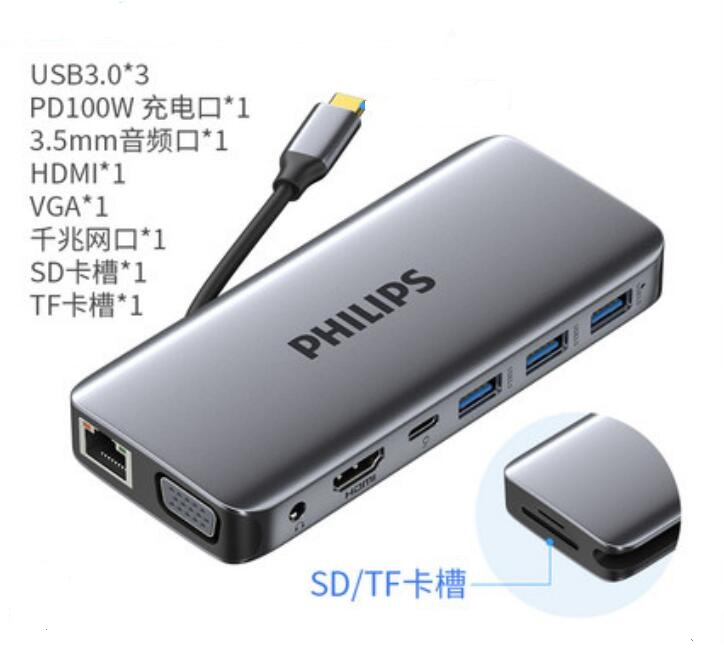
-------------------------------------------------------------------------------------------------------------------------------------------------------------Model 21: HDMI x 1 + VGA x 1
Brand: Philips
Model: 2 in 1 Type-C Smart Docking Station
Interfaces:
- HDMI x 1
- VGA x 1
Cable Length: 15cm
-------------------------------------------------------------------------------------------------------------------------------------------------------------
Model 22: USB3.0 x 4
Brand: Philips
Model: 4 in 1 Type-C Smart Docking Station
Interfaces:
- USB3.0 x 4
Cable Length: 15cm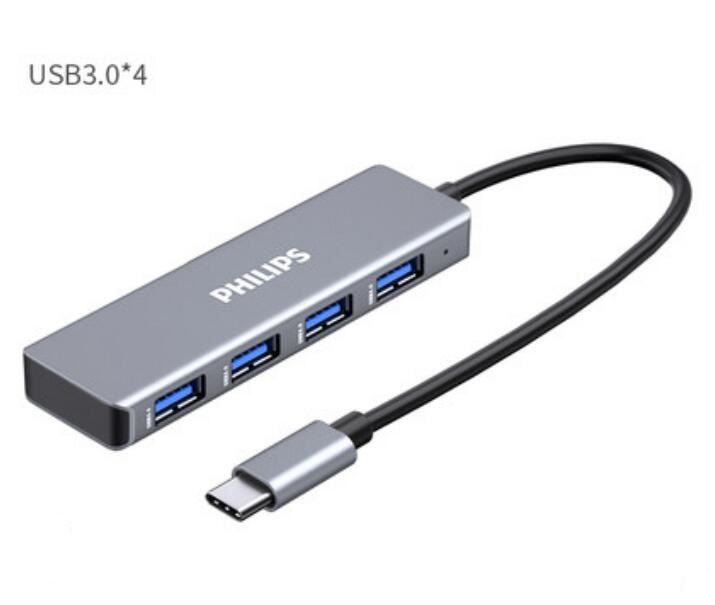
-------------------------------------------------------------------------------------------------------------------------------------------------------------
Model 23: USB3.0 x 4
Brand: Philips
Model: 4 in 1 Type-C Smart Docking Station
Interfaces:
- USB3.0 x 4
Cable Length: 15cm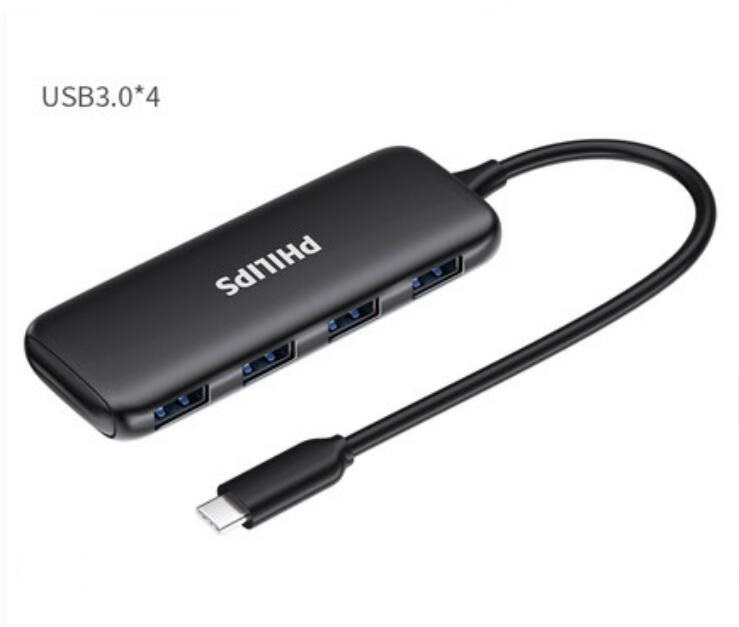
--------------------------------------------------------------------------------------------------------------------------------------------------------------------------------------------------------------------------------------------------------------------------------------------------------------------------
The type-C docking station can be used with the Laptops below:Apple: MacBook 12, MacBook Pro
Huawei: MateBook, MateBook X, MateBook X Pro, MateBook E, MateBook 13
Honor: Magic
Xiaomi: Air 12.5/13, Pro 15.6, Xiaomi GamingBook
ASUS: Zenbook3, U306, U321 Series, U4100, ROG Series
Lenovo: Yoga 5 Pro, ThinkPad X1 Carbon 2017, Mix 720
HP: Pavilion X2, EliteBook Folio G1
Dell: XPS13, XPS15
Google: ChromeBook Pixels, PixelsBook Pen
MicroSoft: Surface Book 2
Razer: Blade Stealth
The type-C docking station can be used with the cell phones below:Huawei: Mate 10, Mate 10 Pro, P20, P20 PRO, P30, P30 Pro
Samsung: Galaxy S8, S8+, S9, S9+, Note8
OPPO: R17 PRO
Buy the Philips Type-C Laptop Docking Station for Desktops here: https://www.4gltemall.com/philips-type-c-laptop-docking-station.html
-
Inseego Launched 5G/LTE Indoor CPE FX2000e
Inseego launches its “Wavemaker PRO” - 5G indoor router FX2000e in several countries around the world. The 5G WiFi router combines 5G / LTE broadband with Ethernet and Wi-Fi 6 and is primarily aimed at small businesses.
Small business router
Inseego, a leading provider of 5G and IoT device-to-cloud solutions, announced that the “Wavemaker PRO” 5G indoor router FX2000e has been approved for use in several markets. This means that the device can be sold worldwide. The 5G router is aimed primarily at smaller companies and decentralized employees who need fast, secure and reliable internet access.
The plug-and-play solution is designed for the fixed wireless area. It combines 5G / LTE broadband with Ethernet and Wi-Fi 6 - Connectivity and powers up to 32 connected devices. “5G solutions are a great choice for broadband access for businesses and consumers in their remote offices and homes,” said Ashish Sharma, Inseego's president of IoT & Mobile Solutions. “Our FX2000e is a compact solution and supports many different use cases for broadband connectivity: Small businesses can get high-speed internet access anywhere. Companies can easily set up a secure WAN solution for their branch offices and remote employees. And SD-WAN providers can now use a 5G WAN connection as the primary broadband connection for decentralized locations. "
Speeds in the gigabit range
The Inseego FX2000e enables speeds in the gigabit range via 5G, if the respective network allows this. The FX2000e is designed to operate in a wide range of global 5G and 4G frequency bands in order to be versatile. In addition, the compact device is equipped with a WAN interface for SD-WAN deployments so that it can also be used as an Internet solution for small residential units or as a cable modem replacement for larger houses with mesh Wi-Fi systems and other connectivity requirements.
The "Wavemaker PRO" -5G indoor router FX2000e is primarily intended for companies such as restaurants, retail locations, branches or home offices. The functionality of the Inseego 5G router is rounded off by the "Inseego Mobile" app. It simplifies installation for end users and offers an intuitive user interface. In addition, IT managers can remotely configure and manage the router and all connected devices using the Inseego Connecti cloud software.
-
Netgear Nighthawk M5 Mobile 5G Router Test
Last year, Netgear offers one of the first mobile 5G routers: The Nighthawk M5. As the successor to the Nighthawk M2, the device with the model name MR5200 not only offers a fast cellular modem, but of course also a large battery, fast WiFi 6 and plenty of connections.
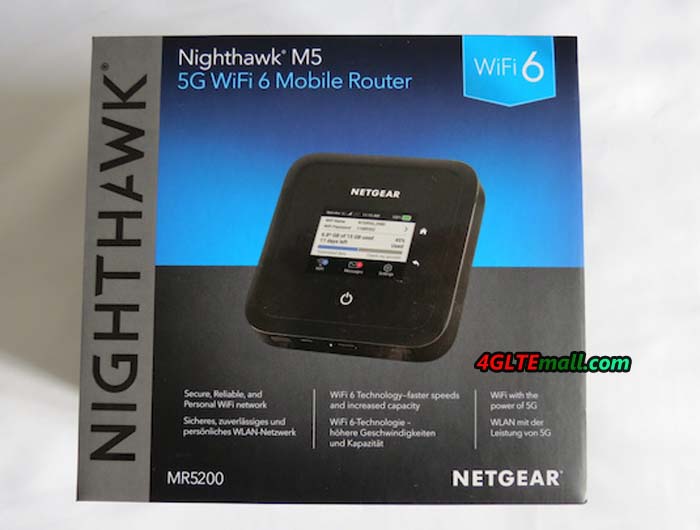
The Netgear Nighthawk M5 MR5200 is packed in a small cardboard box. In addition to the mobile 5G router, the package also includes a power supply unit with adapter for EU and UK plugs, a USB to USB-C cable and a battery with a capacity of 5,000 mAh. A quick start guide and a warranty card are also included.
At first glance, the Netgear Nighthawk M5 differs only slightly from the previous models Nightahwk M1 (MR1100) and Nighthawk M2 (MR2100). All devices have a cuboid design with a large display on the front, the connections are on the lower side.
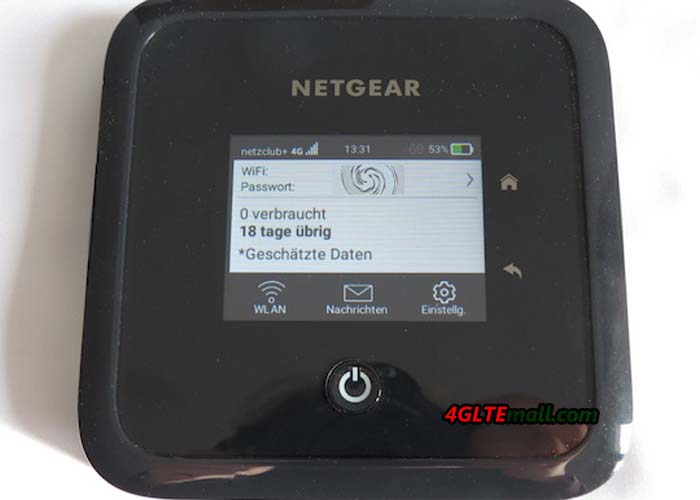
The Nighthawk M5 looks high-quality thanks to the rubberized and structured frame, and the matt back also leaves a positive impression. The front with the touchscreen and buttons is less successful, it has a high-gloss finish and magically attracts fingerprints and scratches. That was solved even better with the Nighthawk M1.
The back of the Nighthawk M5 can also be easily removed. Underneath is the battery and the slot for the SIM card. A welcome innovation compared to the previous models is the slot for the nano SIM card. The M1 and M2 still required micro-SIM cards, so that nano-SIM cards could only be used with an adapter.
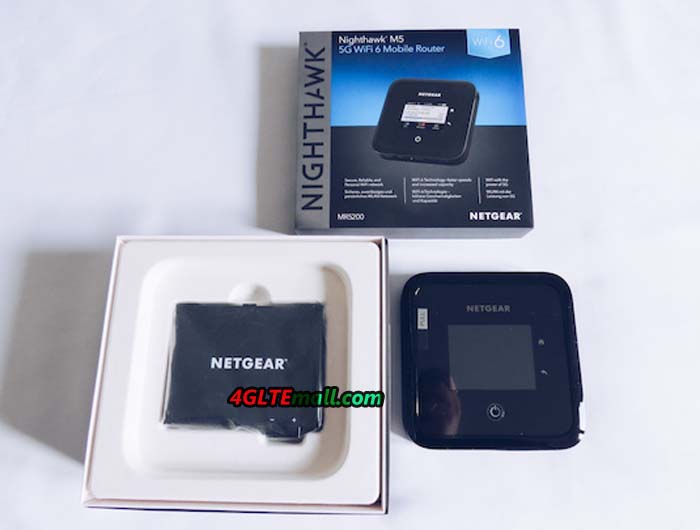
5G modem in the test
The main reason to buy the Netgear Nighthawk M5 is certainly the 5G modem. A Qualcomm Snapdragon X55 chip is installed. Theoretically, the 5G WiFi router can thus achieve speeds of more than one gigabit per second in the downlink and several hundred megabits per second in the uplink. In the practical test, the Nighthawk M5 was tested with a SIM card from Vodafone at several locations in the 5G network, both via LAN and WLAN.
Both the LAN connection and the WLAN represent a bottleneck for maximum Internet speed. The Nighthawk M5 allows a maximum of 1 GBit/s via RJ45 Ethernet, and up to 1.2 GBit/s (5 GHz band) is theoretically possible via WLAN. You should definitely be aware of this limitation.
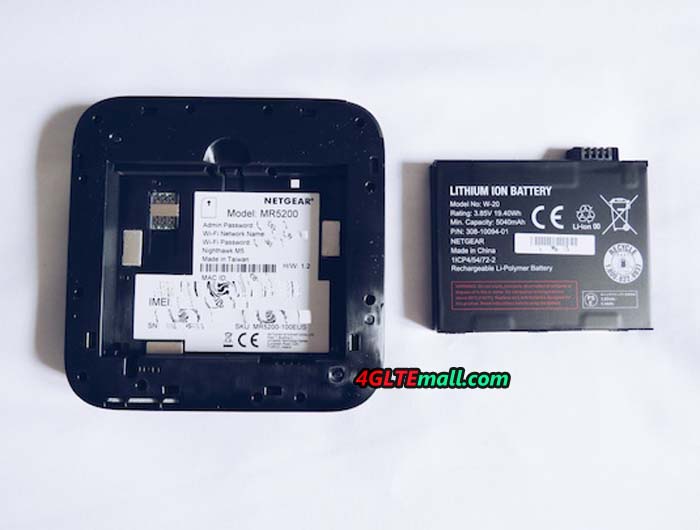
In the 5G network of Vodafone using the frequency range around 3.6 GHz (band n78), around 900 Mbit/s was measured for downloading and around 140 Mbit/s for uploading via LAN. If the connection was made via WLAN, around 800 Mbit/s were possible in the download. In a direct comparison with a measurement on the 5G smartphone, the Nighthawk M5 was slightly slower - around 950 Mbit/s were possible on the iPhone 12 mini under the same test conditions.
The 5G connections are naturally much slower when using dynamic spectrum sharing (DSS, band n1). Vodafone relies widely on 5G n1 with DSS, the Netgear Nighthawk M5 can use the technology without any problems and achieved speeds of up to 300 Mbit/s in the downlink and up to 130 Mbit/s in the uplink in the test. Incidentally, LTE was always a little bit faster at the same location in the downlink, but the uplink speed over 5G was almost twice as high as over LTE. Depending on the server, the latency times were well below 20 milliseconds and thus at a normal level.
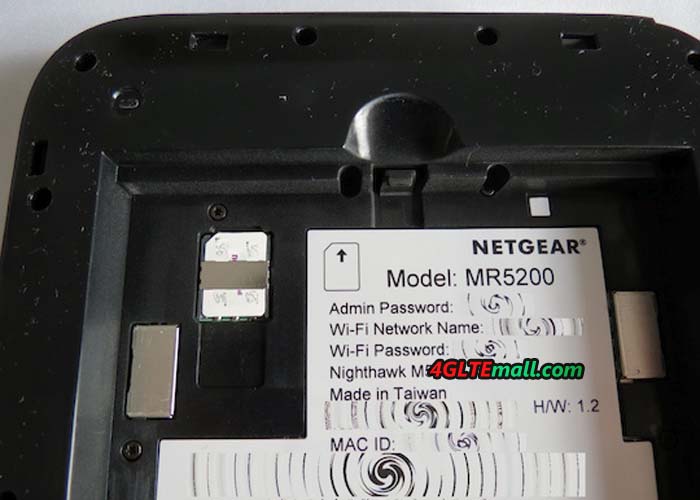
The Netgear Nighthawk M5 supports all 5G frequency ranges that are important for Europe. In detail, these are the bands n1, n3, n5, n7, n8, n20, n28, n38, n40, n77 and n78.
In addition to 5G, the Netgear Nighthawk M5 naturally also supports 4G / LTE and 3G / UMTS. The frequency ranges around 700/800/900/1800/2100/2600 MHz for FDD-LTE and 2300/2600 MHz for TDD LTE are supported here. In the 3G area, the bands around 850/900/1900/2100 MHz are supported. These are good prerequisites for use in Europe, but the Nighthawk M5 is not ideally suited for use in North and South America. It's a shame - many current smartphones offer significantly better frequency band support!
If necessary, you can also connect two external antennas to the Netgear Nighthawk M5 to improve reception quality and increase speeds. For this purpose, Netgear has installed two TS-9 connections on the underside, which are protected from contamination by a rubber cover as standard. If you need the 5G external antenna for Nighthawk M5, we recommend this one: https://www.4gltemall.com/5g-external-antenna.html .
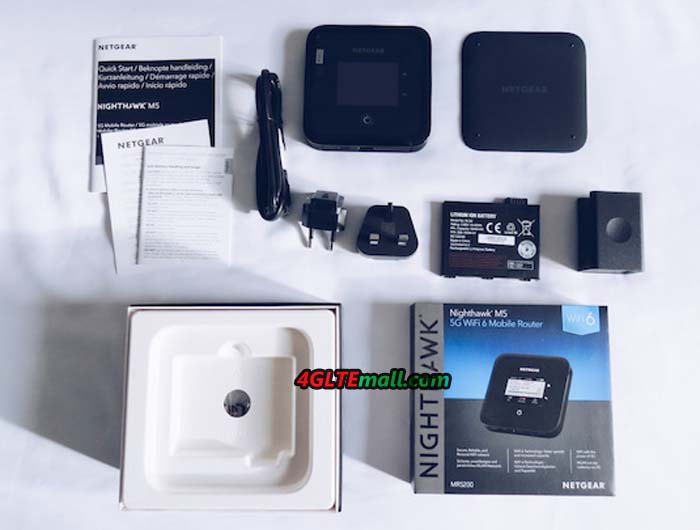
WLAN with repeater function
The Netgear Nighthawk M5 supplies up to 32 devices simultaneously with a WLAN connection. Thanks to the current WLAN 6 standard, speeds of up to 1200 Mbit/s gross in the 5 GHz frequency band and up to 600 Mbit/s in the 2.4 GHz frequency band can be used. However, the speed depends heavily on the device used and on other factors such as the distance. In the test, the speeds were usually significantly lower and fluctuated between 300 and 867 Mbit/s.
The WiFi range of the Netgear Nighthawk M5 turned out to be very decent in the test for a mobile router. An apartment with 80 to 100 m2 can easily be supplied with the small router, provided the walls are not super thick. If necessary, the range can also be reduced to save energy. Incidentally, there is no WLAN timer, but a guest network can be set up. The latest WPA3 encryption is also available on request.
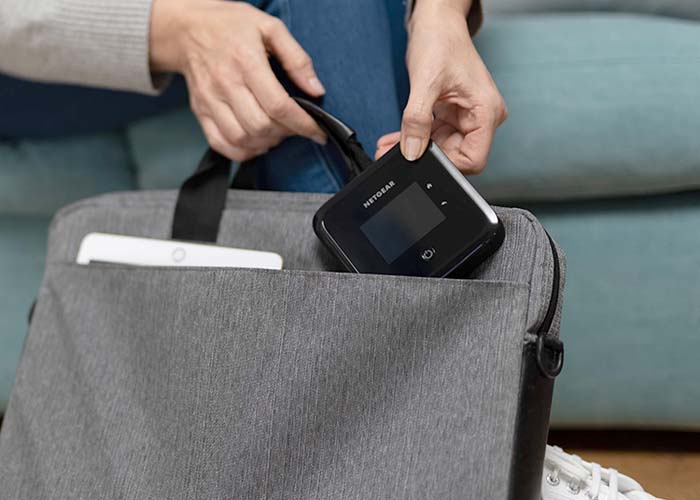
Internet via Ethernet and USB
As an alternative to the wireless connection via WLAN, the Netgear Nighthawk M5 can also share the Internet connection via LAN (RJ45 Ethernet) or via USB interface ("USB tethering"). Both types of cable connection are activated automatically, all you have to do is connect the cable and you are connected to the Internet.
The Nighthawk M5 can be configured so that the WLAN is automatically switched off as soon as a device is connected to the Internet via USB. The USB tethering function can also be deactivated if necessary, then the USB connection can only be used for power supply.
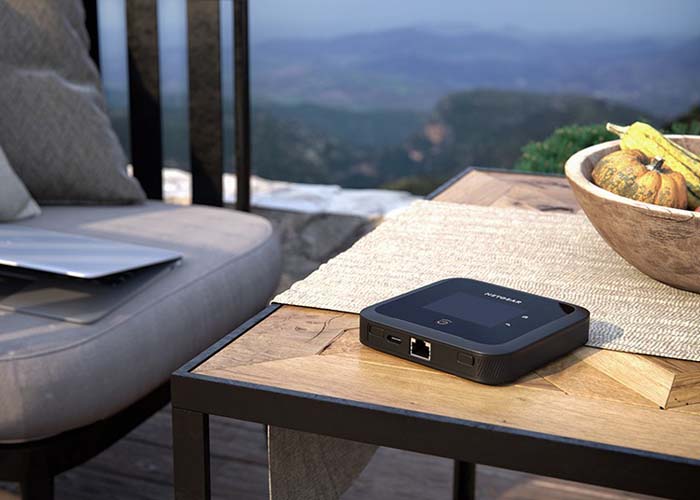
The "data offloading" function allows the LAN port of the Netgear Nighthawk M5 to be configured as a WAN port, ie an existing Internet connection via LAN is also used as soon as the LAN cable is plugged in and an Internet connection is available. If the LAN connection is interrupted, the Nighthawk M5 automatically switches back to the cellular connection.
Display and operation
Most of the settings can be made directly via the touchscreen on the front of the Netgear Nighthawk M5. Here there is, for example, the possibility of changing the name and password of the WLAN, providing a WLAN guest network or changing the WLAN range. Further setting options concern, for example, the cellular connection (APN, preferred network technology, roaming, etc.). It is also possible to carry out a software update directly via the touchscreen.
The display itself is of poor quality compared to a current 5G smartphone, the resolution is low, the color representation is poor and the plastic cover is reflective. There is also not always a reaction to inputs.
A lock screen is shown on the display, showing the time and date. The network operator, the current network technology, the reception strength and the battery status (in percent) are also displayed. The actual start screen can be protected with a PIN if required; the WLAN data and the data volume used can be displayed here if required.
At the bottom of the start screen there are shortcuts for WiFi, SMS and settings. By the way, SMS can not only be received on the Netgear Nighthawk M5, but also sent.
Some information on the cellular connection can be viewed via the “Status” menu item. This includes, for example, the current network status, the technology used and the main frequency band, the reception strength (RSRP) and the IP addresses. Unfortunately, when the 5G (NSA) connection is active, there is no detailed information on the frequency bands; here, too, only the main radio cell (LTE anchor cell) is displayed, the network status signals "5GSUB6".
Web interface and app
In addition to the touchscreen, the browser web interface can of course also be used for configuration. The visual appearance of the web interface has hardly changed compared to the previous models and offers more functionality than the app and the touchscreen. For example, the WLAN repeater function (WLAN as Internet access) or the WAN function (Internet access via LAN or failover) can also be activated via the web interface.
The web interface reacts quickly and is clearly structured. The range of functions is basically good, but there is still a lot of potential for improvement in the details. For example, 5G and/or LTE can be deactivated if necessary. However, manual selection of the frequency bands is not possible. Detailed information on the frequency bands used by the Nighthawk M5 is also nowhere available, although this information would certainly be very interesting for some users.
The “NETGEAR Mobile” app is available for both Android and iOS and enables the Nighthawk M5 to be configured easily and clearly using a smartphone. All functions from the web interface can also be used via the app, for example the "data offloading" feature. The app responded quickly and reliably in the test on an Apple iPhone.
Battery and power supply
The 5,000 mAh battery of the Netgear Nighthawk M5 is easily exchangeable by the user, so if necessary, a second or third battery can be bought to swap instead of recharging on the go. The battery life in the test was around 8 hours with continuous 5G use (Internet radio stream via WLAN).
For longer stationary use, it can be advisable to remove the battery from the router and only operate the device directly on the power supply unit via a USB cable. This has the advantage that the heat development is significantly lower. In the test it happened that the Nighthawk M5 got very warm after intensive use (2 WLAN devices, streaming) and simultaneous charging of the battery.
Conclusion: Netgear Nighthawk M5
The Netgear Nighthawk M5 made a good impression in the test. 5G modem and WLAN are very fast, there are many connections and operation are impressive. The Nighthawk M5 has to accept criticism, for example, for its weak LTE frequency band support. Even simple 5G smartphones allow better connections abroad than the Nighthawk M5, as they can use many more frequency ranges. There is also room for improvement in the software: some users will miss a timer function for the WLAN, others will miss more detailed information and setting options for the cellular connection.
If you really want to have 5G in your mobile router, you can hardly ignore the Nighthawk M5. If LTE is enough for you, you will find almost equivalent alternatives in the cheaper sister models Nighthawk M1 and Nighthawk M2.

